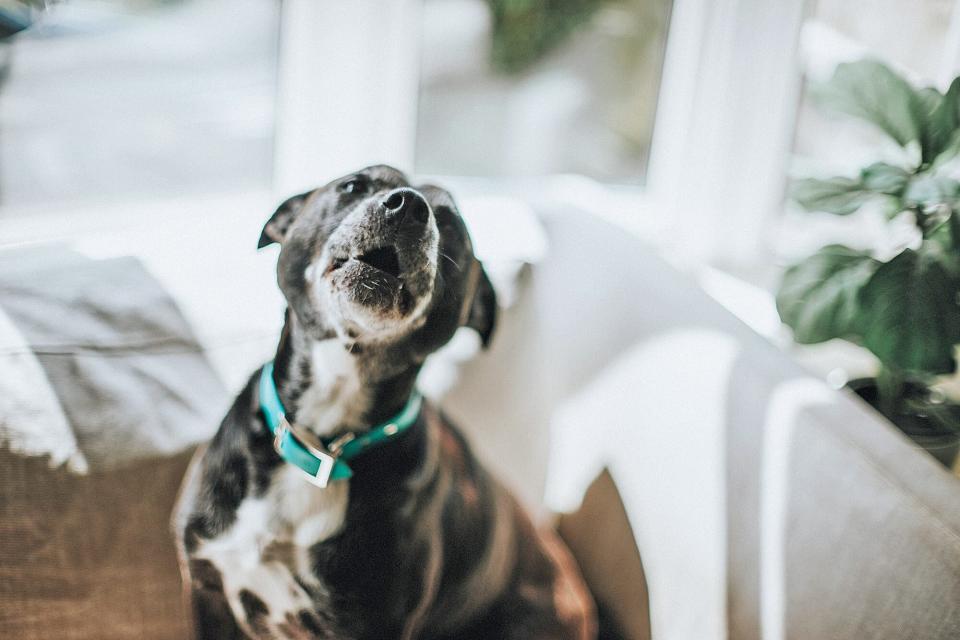Those Quiet Ears for Dogs You've Seen on TikTok? Here's What a Pet Pro Has To Say
When you first see those images of "quiet ears" for dogs, they might seem like a good way to help your dog relax or keep her from barking. Who doesn't want to try anything and everything to help calm an anxious dog? The small hoods that slide over your dog's head even look incredibly cute—just witness Myko and his Eeyore-style ears, a partnership that's yielded millions of views on TikTok.
Dogs, however, need their ears to both hear and stay alert. So generally it's not a good idea to cover them up, says Daily Paws Pet Health and Behavior Editor Haylee Bergeland, CPDT-KA, CBCC-KA, RBT. Covering the ears could stress some dogs out even more, she says.
Myko's owner, Elena, tells Daily Paws she's seen how the ears have calmed her dog, who likely experienced some trauma before his adoption. His fears of ceiling fans, trash trucks, thunder, and many other things caused plenty of worry as his family worked hard to help him and his anxiety.

Catherine Falls Commercial / Getty
Elena says she consulted with her veterinarian and trainers, she tried CBD products, distraction, and other strategies. Myko would respond well to training, but when his fear response took over, the barking would start, she says. Then, one night when Myko was particularly upset—he had barked for 30 minutes nonstop at a reflection in a window—his family remembered reading how compression clothes like thundershirts can help a dog's anxiety. So they decided to turn to an old Halloween costume and placed the Eeyore ears on Myko's head.
"We put them on him and he became very quiet and calm," Elena says. "We instantly marked that behavior with a high-value reward and he stayed quiet. This absolutely created an association between the ears, being quiet, and getting rewarded."
Each time he wears the ears, he gets a treat when he calms down, which usually only takes 1 or 2 minutes, Elena says. She believes her dog associates the ears with being calm.
Could this strategy work for other dogs? Bergeland is skeptical. "There is no data to support covering a dog's head or ears to make them calmer," she says. Covering dogs' ears may stop them from barking, but it's likely because they're stressed—rather than the covering relaxing them. Plus, it probably won't stop them from barking in the future.
Bergeland suggests alternatives dog owners can try—whether you're looking to stop your dogs' barking or calm them down during a thunderstorm, fireworks display, or other stressful situation.
RELATED: Does My Dog Have Anxiety?
The solutions for helping your dog stay calm range from extremely simple ones to strategies that will take a little time and training.
Stopping My Dog from Barking
So, if your dog is barking, the first thing to try is to keep your dog away from whatever they are barking at. Does she bark out the window? Close the blinds or curtains or block off the area so she can't get there, Bergeland says. It could be that easy.
The key is to identify why your dog is barking. (You'll want to make sure you're not the one who's reinforcing the behavior.) If you know what's behind it, you'll know when to step in. That's when you can distract your dog or teach them a new behavior—using positive reinforcement methods, naturally. You never want to punish your dog. She doesn't know she's done anything wrong by barking. It's a natural thing for her.
For all you need to know about your dog's barking—and how to sometimes prevent it—read our guide here.
Easing My Dog's Stress
If the thunderstorm or fireworks outside are giving your dog anxiety, you can fashion your dog a safe space somewhere in your house, Bergeland says. You can maybe even equip the room with a white noise machine, drowning out the stressful noises while still allowing your dog to hear (which might be harder for your dog under quiet ears or a hood).
You can also try some counterconditioning and desensitization, Bergeland says. Counterconditioning is a way to work towards replacing the fear or anxiety your dog is feeling. For example, if your dog is afraid of thunderstorms, you can give her a treat when she hears a thunderclap. Over time, she'll theoretically associate feeling good—dogs usually enjoy yummy treats—with the thunder.
Desensitization entails exposing your dog to the stressor over a long period of time, while increasing the level of the stressor slowly. For example, you could play low-volume thunder noises when your dog is around, slowly increasing the volume as she gets used to it. Eventually, you'll hopefully reach full exposure with your dog, who will ideally be less afraid or stressed.
Both strategies, which you can learn more about here, require time and commitment, and aren't guaranteed to work. To get started, consult with a certified pet behavior professional who focuses on positive reinforcement. To find a certified professional near you, visit the CCPDT or the IAABC.
Editor's Note: This story has been edited from the original version, to include quotes from Myko's owner.

